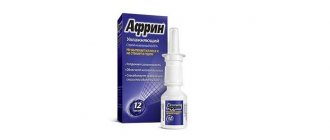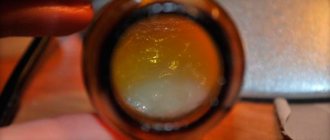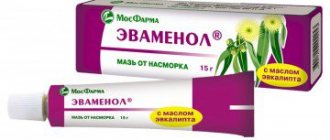A runny nose, nasal congestion, respiratory infections, and clinical signs of sinusitis are always associated with the use of various types of nasal drops that ease breathing and help cope with the symptoms of the disease. However, there is another unjustifiably forgotten form of medicines for the treatment of colds - ointment. It has a number of advantages compared to liquid medicines. One of these drugs is Preobrazhensky ointment, which has a complex composition.
Advantages
Manufactured by pharmacy chains or produced in finished form, ointments have a number of advantages compared to drops:
- The composition applied to the inner surface of the nose remains on the surface of the mucous membranes much longer and contributes to a longer exposure time.
- It does not flow down the back wall of the nasopharynx, which means there is no risk of the product getting into the eustachian tube or gastrointestinal tract, which is extremely important in the treatment of rhinitis in young children.
- When applying the ointment, a longer anti-inflammatory, antimicrobial, vasoconstrictor effect is provided than when using sprays and drops.
- When applying products with a complex composition, such as Preobrazhensky ointment, a long-lasting anti-inflammatory, antiseptic, antiviral, vasoconstrictor effect is ensured, which significantly improves the results of therapeutic measures.
- Such products, which have the consistency of creams or gels, usually contain components that nourish and moisturize the surface of the mucous membrane, which prevents it from drying out and promotes regeneration and restoration.
Preobrazhensky ointment is a medicine that has been proven over the years for the treatment of runny nose, sinusitis, and cold symptoms.
Compound
The main components of the drug are:
- The base of the product is Vaseline.
- Natural ingredients – camphor and eucalyptus oil.
- Ephedrine hydrochloride.
- Streptocide.
- Sulfadimezin.
- Norsulfazole.
During manufacturing, all components of the product are taken in strictly defined proportional ratios, allowing to potentiate the effect of each other. The pharmaceutical industry produces a ready-made nasal drug called Sunoref, which is an analogue.
The use of a local combined drug - Preobrazhensky ointment - allows for a long-term therapeutic effect on all mechanisms of the inflammatory process in the upper respiratory tract and sinuses.
Mechanism of action
It has antibacterial, anti-inflammatory, vasoconstrictor, antiseptic and anti-edematous effects. The therapeutic effects are provided by the components included in the ointment, which mutually enhance each other’s effects:
- Streptocide - has activity against many infectious agents: streptococcus, Escherichia coli, meningococcus, gonorrhea, pneumococcus. It has a pronounced bacteriostatic effect, disrupting the synthesis of nucleic acids in pathogenic microorganisms, thereby preventing their reproduction.
- Sulfadimezin is another antibacterial component in the ointment. It has a bacteriostatic effect on clostridia, Escherichia coli, the causative agent of diphtheria, Klebsiella, Yersinia and other microorganisms that stain and do not stain according to Gram.
- Norsulfazole is a sulfonamide drug that stops the growth and reproduction of pathogenic cocci, Escherichia coli, chlamydia, the causative agent of diphtheria, and toxoplasmosis.
- Ephedrine salt (hydrochloride) – has a pronounced vasoconstrictor effect. Helps increase blood pressure and has a bronchodilator effect. In recent years, its use in Russia and European countries has been controlled and limited due to the pronounced psychostimulant effects that ephedrine can provide. Can be replaced by other components with a vasoconstrictor mechanism of action.
- Camphor oil is an antiseptic, analgesic with a pronounced anti-inflammatory effect, helps improve trophic processes in tissues.
- Eucalyptus oil is a natural phytoncide. It has anti-inflammatory, antifungicidal, antiseptic and antibacterial properties. Is a natural adaptogen.
Vaseline, as a base for making ointment, has softening, moisturizing properties, preventing the surface on which the product is applied from drying out. It is a medium through which chemical substances of different structures retain their properties and have therapeutic effects.
Preobrazhensky drops in the nose
One of the most famous drugs. It is believed that the active substance - oxylin - can negatively affect herpes viruses, influenza, and viral rhinitis. For treatment, oxolinic ointment, however, is rarely used, but is recommended in the following cases:
- if there is a flu epidemic in the city and you need to somehow protect yourself from it;
- if the patient has viral rhinitis and the body needs support.
Anti-virus ointment is applied to the nose several times a day - but no more than four - and must be supplemented with general prevention of viral infection.
The active substance does not tend to accumulate in the body, but it still has contraindications. The drug is not used if:
- a person has increased sensitivity to its components;
- the person is too young - oxolinic ointment is not used to treat infants;
- during pregnancy and lactation - only after the first trimester.
The ointment should not be used for longer than twenty days, otherwise addiction will occur and it will completely lose its properties. In addition, it should not be used together with vasoconstrictor drugs, otherwise there is a high probability that the patient’s mucous membrane will dry out and as a result, the nose will bleed.
Preobrazhensky ointment
Known among nasal ointments for a long time, this ointment is used not so much to destroy viruses, but to soften the mucous membrane, destroy pathogenic microorganisms and make breathing easier. It has a complex effect - it moisturizes, relieves inflammation, and slightly constricts blood vessels.
It is useless to use it for prevention - it is used when the patient’s runny nose of viral origin is already in full swing. Unless, of course, there are contraindications:
- problems with the hormonal system - a drug with the effect of constricting blood vessels can have an additional negative effect on it;
- atherosclerosis – vessels in this disease are weak, it is harmful for them to narrow and expand too often;
- heart problems and high blood pressure - when used, the ointment results in pain and heaviness in the chest.
Do not use it to prevent colds, for children, or for periods that last longer than a week, since over time it becomes addictive.
The dosage is different for children and adults. The first - twice a day for ten minutes, the second three times for fifteen minutes, and if you want to speed up the effect, then for twenty.
Viferon
It not only helps to cope with viruses in the body, but also boosts immunity, which together is simply excellent for treating any viral infection. Its indications for use are simple - any viral inflammation of the respiratory tract. It could be:
- rhinitis, in which the nose is stuffy, hurts and constantly emits snot;
- influenza, in which the patient has a fever but does not sneeze or cough.
Any viral infection - from a runny nose to pneumonia - is a reason to use Viferon for treatment. There are practically no contraindications for the ointment. It is poorly absorbed and affects mainly the area that is lubricated with it. Therefore, it is used to treat children, pregnant and lactating women. Moreover, in medicine it is also used to treat premature babies.
There is only one contraindication – hypersensitivity to the components, which is extremely rare. Sometimes side effects develop, usually allergic reactions. Itching, redness of the skin, urticaria. They disappear three days after the drug is stopped.
Infagel
Combines antiviral properties with the ability to enhance immunity and relieve inflammation. It is rarely used for direct treatment - it is mainly used to provide prevention to people who are in constant contact with patients who suffer from a viral infection.
They apply it for three weeks, and in the first and third weeks they apply a thin layer of ointment under the nose twice a day, and in the second week they take a break so that the body has time to rest and adapt to the active substance that it has to deal with.
Ointment is contraindicated in very rare cases - it is usually used to treat pregnant women, lactating women, and even infants. And don’t use it at all only if:
- the patient has an allergic reaction in the process of exacerbation;
- The patient is allergic to the components of the antiviral ointment.
The drug is sold in pharmacies without a prescription, but you should not abuse it - it, like other antiviral drugs, should only be prescribed by a doctor.
Auxiliary ointments
In addition to drugs that have a pronounced antiviral effect and are used for colds and flu directly to kill the pathogen, there is a whole list of ointments that can contribute to this process. They will not cope with the virus, but will support the body. Among them:
- Levomekol. Relieves inflammation, accelerates metabolism at the local level, which helps the body cope faster. Not prescribed during pregnancy, lactation and if you are prone to allergies.
- Vishnevsky ointment. It also relieves inflammation, restores the mucous membrane and has a healing effect on it. It is used no longer than a week, since then the likelihood of allergies increases. Not prescribed for children under six years of age, pregnant women, people with kidney pathologies and allergy sufferers.
- Evamenol. Constricts blood vessels, relieves pain, which is usually very useful for viral infections. Relieves symptoms of inflammation, alleviates the condition. Use it no more than three times a day, no longer than ten days. Not prescribed for children under two years old.
- Pinosol. There are drops with this name, but not everyone knows that there is also an ointment. It moisturizes the mucous membranes, has an anti-inflammatory effect, and alleviates the general condition. The course of treatment is up to two weeks; side effects sometimes include allergies, itching, burning and swelling. Do not use the ointment to treat children under two years of age and people prone to allergic reactions.
Sometimes doctors additionally prescribe homeopathy, but there is still debate about how effective it is, and it is a personal matter for each patient whether to take such drugs or not.
Advantages
Manufactured by pharmacy chains or produced in finished form, ointments have a number of advantages compared to drops:
- The composition applied to the inner surface of the nose remains on the surface of the mucous membranes much longer and contributes to a longer exposure time.
- It does not flow down the back wall of the nasopharynx, which means there is no risk of the product getting into the eustachian tube or gastrointestinal tract, which is extremely important in the treatment of rhinitis in young children.
- When applying the ointment, a longer anti-inflammatory, antimicrobial, vasoconstrictor effect is provided than when using sprays and drops.
- When applying products with a complex composition, such as Preobrazhensky ointment, a long-lasting anti-inflammatory, antiseptic, antiviral, vasoconstrictor effect is ensured, which significantly improves the results of therapeutic measures.
- Such products, which have the consistency of creams or gels, usually contain components that nourish and moisturize the surface of the mucous membrane, which prevents it from drying out and promotes regeneration and restoration.
Preobrazhensky ointment is a medicine that has been proven over the years for the treatment of runny nose, sinusitis, and cold symptoms.
Compound
The main components of the drug are:
- The base of the product is Vaseline.
- Natural ingredients – camphor and eucalyptus oil.
- Ephedrine hydrochloride.
- Streptocide.
- Sulfadimezin.
- Norsulfazole.
During manufacturing, all components of the product are taken in strictly defined proportional ratios, allowing to potentiate the effect of each other. The pharmaceutical industry produces a ready-made nasal drug called Sunoref, which is an analogue.
The use of a local combined drug - Preobrazhensky ointment - allows for a long-term therapeutic effect on all mechanisms of the inflammatory process in the upper respiratory tract and sinuses.
Mechanism of action
It has antibacterial, anti-inflammatory, vasoconstrictor, antiseptic and anti-edematous effects. The therapeutic effects are provided by the components included in the ointment, which mutually enhance each other’s effects:
- Streptocide - has activity against many infectious agents: streptococcus, Escherichia coli, meningococcus, gonorrhea, pneumococcus. It has a pronounced bacteriostatic effect, disrupting the synthesis of nucleic acids in pathogenic microorganisms, thereby preventing their reproduction.
- Sulfadimezin is another antibacterial component in the ointment. It has a bacteriostatic effect on clostridia, Escherichia coli, the causative agent of diphtheria, Klebsiella, Yersinia and other microorganisms that stain and do not stain according to Gram.
- Norsulfazole is a sulfonamide drug that stops the growth and reproduction of pathogenic cocci, Escherichia coli, chlamydia, the causative agent of diphtheria, and toxoplasmosis.
- Ephedrine salt (hydrochloride) – has a pronounced vasoconstrictor effect. Helps increase blood pressure and has a bronchodilator effect. In recent years, its use in Russia and European countries has been controlled and limited due to the pronounced psychostimulant effects that ephedrine can provide. Can be replaced by other components with a vasoconstrictor mechanism of action.
- Camphor oil is an antiseptic, analgesic with a pronounced anti-inflammatory effect, helps improve trophic processes in tissues.
- Eucalyptus oil is a natural phytoncide. It has anti-inflammatory, antifungicidal, antiseptic and antibacterial properties. Is a natural adaptogen.
Vaseline, as a base for making ointment, has softening, moisturizing properties, preventing the surface on which the product is applied from drying out. It is a medium through which chemical substances of different structures retain their properties and have therapeutic effects.
Indications
Preobrazhensky ointment can be recommended for use by those for whom the use of vasoconstrictor drops and systemic antibacterial agents is contraindicated, including pregnant women and pediatric patients.
Indications for prescribing the drug are:
- Rhinitis with acute or chronic protracted course, caused by bacterial infections or allergic nature.
- Inflammatory diseases of the paranasal sinuses: maxillary, frontal, main.
Important! The use of products that contain components with a pronounced antibacterial effect is not indicated for relieving the symptoms of a viral infection.
Contraindications
Preobrazhensky ointment should not be prescribed in the following cases:
- In case of existing allergic manifestations to one of the components included in the medicinal product.
- For signs of heart failure, rhythm disturbances, high blood pressure.
- With hyperfunction of the thyroid gland.
- For sleep disturbances, increased excitability, severe changes in the central nervous system, accompanied by convulsive syndrome.
- With clinically pronounced manifestations of vascular atherosclerosis.
- In case of insufficiency of kidney function.
The ointment can be used only as prescribed by a doctor.
Side effects
Taking into account the multicomponent composition, the most common undesirable effect is the occurrence of an allergic reaction, which can manifest itself as lacrimation, sneezing, urticaria, and the development of angioedema.
Adverse reactions are caused by the active ingredients contained in the drug. While using the ointment, the following symptoms may occur:
- The appearance of feelings of anxiety, restlessness, increased excitability.
- Nausea, vomiting, dizziness, migraine-like pain.
- Increased heart rate.
Rarely, inhibition of hematopoiesis may occur, the consequence of which is agranulocytosis. Such a serious complication is possible if patients violate the doctor’s recommendations and instructions for use.
What to apply to your nose when you have a runny nose?
All existing ointments for the common cold can be divided into the following medicinal groups:
- antiviral – widely used for prevention, especially during epidemic outbreaks;
- antiseptic – used in the treatment of bacterial infections;
- combined – have a general therapeutic effect, used in a complex manner;
- homeopathic - based on natural ingredients, used as part of a comprehensive treatment of the disease.
The causes of rhinitis are infection or the body’s reaction to an allergen. It can be pet fur, flowering plants, household dust. Before using one or another remedy, you need to determine the cause of the disease.
What ointments for a runny nose can be used for children?
Many parents believe that ointments can help in treating a runny nose, since they have a thick consistency and do not get into the throat, which often causes discomfort in a small child.
However, you should listen to the opinion of experts who claim that not all of them can be recommended for children.
Safe for children over 2 years old are Golden Star (Asterisk) balm, Evamenol, Fleming and Thuja ointments. They are based on petroleum jelly and herbal extracts.
After consultation with the doctor, it is possible to use oxolinic and ichthyol ointments, Viferon. It should be noted that the listed drugs will be truly effective only as part of complex therapy.
Source: //yazdorov.win/prostuda/kapli-preobrazhenskogo-v-nos.html
Indications
Preobrazhensky ointment can be recommended for use by those for whom the use of vasoconstrictor drops and systemic antibacterial agents is contraindicated, including pregnant women and pediatric patients.
Indications for prescribing the drug are:
- Rhinitis with acute or chronic protracted course, caused by bacterial infections or allergic nature.
- Inflammatory diseases of the paranasal sinuses: maxillary, frontal, main.
Important! The use of products that contain components with a pronounced antibacterial effect is not indicated for relieving the symptoms of a viral infection.
Types of ointments for runny nose
For the successful treatment of rhinitis, several types of ointments have been developed, including:
- antiseptic and antibacterial;
- antiviral;
- decongestants and vasoconstrictors;
- regenerating;
- homeopathic.
Abusing ointments and using them for other purposes is not recommended at all. An antibacterial agent, for example, will be absolutely useless for viral rhinitis, and homeopathic ointment will not help for bacterial rhinitis.
Ointments for the common cold can be successfully combined with various medications
Contraindications
Preobrazhensky ointment should not be prescribed in the following cases:
- In case of existing allergic manifestations to one of the components included in the medicinal product.
- For signs of heart failure, rhythm disturbances, high blood pressure.
- With hyperfunction of the thyroid gland.
- For sleep disturbances, increased excitability, severe changes in the central nervous system, accompanied by convulsive syndrome.
- With clinically pronounced manifestations of vascular atherosclerosis.
- In case of insufficiency of kidney function.
The ointment can be used only as prescribed by a doctor.
Regenerating and homeopathic
Ointments included in this group are created from natural ingredients. Occasionally, some of them are combined with synthetic substances that serve to enhance the effect. Plant-based preparations have antiviral, antiseptic, immunomodulatory, regenerating and decongestant effects. The spectrum is quite broad, but ointments may not be useful if bacterial rhinitis is diagnosed, since it requires treatment with antibiotics (often happens during the flu).
The list of funds in this group is long:
- Thuja ointment;
- Doctor Mom;
- Suprima Plus;
- Star;
- Pinosol;
- Mentoclar and many others.
Side effects
Taking into account the multicomponent composition, the most common undesirable effect is the occurrence of an allergic reaction, which can manifest itself as lacrimation, sneezing, urticaria, and the development of angioedema.
Adverse reactions are caused by the active ingredients contained in the drug. While using the ointment, the following symptoms may occur:
- The appearance of feelings of anxiety, restlessness, increased excitability.
- Nausea, vomiting, dizziness, migraine-like pain.
- Increased heart rate.
Rarely, inhibition of hematopoiesis may occur, the consequence of which is agranulocytosis. Such a serious complication is possible if patients violate the doctor’s recommendations and instructions for use.
Regimes and doses
Before using Preobrazhensky ointment for the nose, the instructions stipulate compliance with the following rules regarding methods of use and dosage of the drug. Performing them helps to avoid not only unwanted side effects, but also improve treatment results:
- The ointment is used only topically and only to lubricate the nasal passages. It is prohibited to use the composition in other ways.
- Before applying the ointment, it is recommended to clear the nasal passages of accumulations of mucus and pathological secretions.
- It is recommended to use the product in one of two ways: either by placing the ointment directly into the nasal passages, or by inserting ointment turundas into the lumen for 10–15 minutes.
- If the ointment is used in children, turundas are inserted alternately into each nasal passage for 10–15 minutes.
It is recommended to use the product 2 to 3 times a day, the course of treatment is up to 10 days.
You can use Preobrazhensky ointment only after consultation with your doctor.
Antiseptic and antibacterial
If a runny nose is the result of hypothermia, then with a high degree of probability we can say that there is a bacterial infection in the nose. In this case, an antiseptic nasal ointment for a runny nose will have an anti-inflammatory effect, become a barrier to new bacteria and eliminate congestion. This group has the most funds, since among them there are both time-tested recipes and more modern drugs. The first include:
- Levomekol;
- ointment with boric acid;
- protarhead;
- Vishnevsky ointment;
- zinc with menthol;
- tetracycline;
- streptomycin;
- chloramphenicol;
- Preobrazhensky ointment.
The use of Levomekol quickly eliminates the feeling of congestion
Modern antiseptics are represented by the following ointment-like drugs: Bactroban and Miramistin. The first drug is good because it can be used in conditions of recurrent rhinitis, since it prevents the proliferation of microbes at the cellular level. Prohibited for use in case of sensitivity to the active ingredient – mupirocin.
Miramistin is an ointment that copes not only with pathogens of rhinitis, but also with more powerful viruses and fungi. It has almost no side effects, and also no contraindications (except for individual intolerance). Popular with both adults and children.











